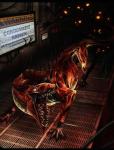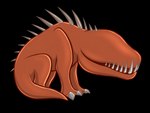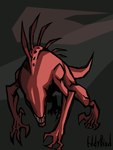
Species: scp-939
SCP-939 is a monster species from the mythos of the SCP Foundation website. Their debut story, SCP-939 — With Many Voices, was posted in April 2011 by their co-writers Adam Smascher and EchoDeltaFour. The story consists of a main page with three supplementary pages — Initial Contact Log SCP-939, Reproduction Of SCP-939, and Incident Report AMN-C227-939 — as well as a cross-experiment listed in the first volume of Experiment Log 914, a supplement of SCP-914's story.
SCP-939 is a species of quadrupedal, digitigrade, Keter-class predators of roughly canid morphology, with adults averaging at a weight of 250 kilograms (551 pounds) and height of 2.2 meters tall (7.22 feet) when on hind legs. Despite having a mammalian physiology, they possess several features commonly seen in animals of a troglobitic lifestyle, such as the vestiges or most notably the complete absence of organ systems. SCP-939 naturally live in pack structures, with an unknown population remaining uncontained across the Americas.
Adult specimens are deep blood red in color, due to their red insides — which are rich in a protein of significant chemical similarity to hemoglobin — being visible through their translucent skin. This skin is also faintly red, hairless, and highly permeable to moisture. SCP-939 locomote on four-toed paws; the weight is placed on three clawed toes with a fourth opposable thumb, the palms of which are covered in setae that greatly assist SCP-939 in traction and climbing.
SCP-939 are almost completely blind, as they have no eyes but instead an array of small eyespots along the spine that can detect intensity of light, with SCP-939 having an aversion to bright lights due to pain. Due to this, SCP-939 mostly locate using auditory and thermal perception, the latter done through sensitive pit organs that detect heat. It is also presumed that the dorsal ridge of SCP-939, made of several spines that can grow up to sixteen centimeters in length, can detect fluctuations in air pressure and currents. The heads of SCP-939 lack a cranium, and consequently a brain, eyes, or even vestigial eye sockets; what could be considered a SCP-939's "skull" are a pair of elongated jaws with equal mobility and a bite-force of over 35 megapascals (5,076 pound-force per square inch). These jaws are lined with several thin sharp teeth comparable to those of the viperfish (Chauliodus), only that they are six-centimeters-long on average and have a faint red glow. The gums of each of these teeth are encircled with tiny thermoreceptors, despite the rest of the body's complete lack of any identifiable form of nervous systems or circulatory systems.
The SCP-939 digestive system consists solely of the esophagus, which possibly exists in part in non-Euclidean space; testing with SCP-914 would indicate that an SCP-939 could have up to seventeen meters of esophageal tissue divided into numerous coils. As SCP-939 do not have a stomach or intestinal tract, whatever an SCP-939 is consumes is eventually regurgitated, with exception to a prey's vocal cords. SCP-939 are capable of imitating animal speech patterns, with a great affinity in replicating human speech; an SCP-939 can perfectly replicate the voice of a person it has killed and consumed the vocal cords of, repeating any prior statement made by the prey, often ones the SCP-939 heard from them prior to their killing. How SCP-939 are capable of this or if they have a comprehension of language is unknown to the SCP Foundation, but they are recognized as highly deceptive in nature, using distressed vocalizations to lure potential victims towards themselves and circumvent voice-analytical security measures.
As they lack a circulatory system, an SCP-939's respiratory system is functional only for vocalizations and dissemination of an aerosolized amnestic compound designated AMN-C227. Exhaled in trace amounts by SCP-939, AMN-C227 is colorless, odorless, tasteless, and potent, making it something easily exposed to in a closed and/or poorly ventilated environment. Inhalation of AMN-C227 causes temporary anterograde amnesia, inhibiting memory formation for the duration of exposure, plus an average of thirty minutes. Removal from environments rich in AMN-C227 have resulted in symptoms similar to withdrawals caused by several psychoactive drugs. Due to the primary effect, AMN-C227 was harvested by the SCP Foundation from 1987 to 1992 for the manufacture of Class-C amnestics to be used by recovery teams, but was retired after a previously unknown side-effect was discovered; that exposure to amnestics produced with AMN-C227 would subconsciously draw amnesticized civilians to wild populations of SCP-939, causing an increase in SCP-939 related disappearances.
SCP-939 possess a form of reproductive system and go into heat in mid-summer (approximately September 8th to October 7th in Northern Hemisphere, March 6th to April 4th in Southern Hemisphere). SCP-939 were not known to be capable of reproduction until ten years after the species was first contained by the SCP Foundation, when the specimen SCP-939-1 gave live birth to a litter of six; of the litter, only one specimen (SCP-939-101, initially SCP-939-A6) was allowed to mature for observation of the SCP-939 life cycle.
Newborn SCP-939 are identical to human infants. If an SCP-939 is stillborn, the mother will instinctually cannibalize the deceased child. Mothers also do not appear to have any defensiveness at attempt to take their children from them, presumably with the intent that their young be acquired by an actual human as a form of brood parasitism. The young will experience mental and physical development as expected for a child until approximately the age of nine; at this point the juvenile SCP-939 will undergo a transformation into a more mature specimen. The SCP-939 will initially develop symptoms of an increased heartrate, headache, and aversion to light, which will intensify over a couple of weeks. It will then suffer from hypersensitivity to auditory stimuli, intense chest and abdominal pain, and an increasing fever as their internal anatomy transfigures itself. If the SCP-939 is able to submerge itself in water, it will enter a comatose state for a few tens of hours before regaining consciousness; upon which it will tear its human skin and head off, revealing an adolescent SCP-939, and autocannibalize its old skin. After transformation, the specimen will begin to adopt behavior typical of other SCP-939.
Over a hundred specimens of SCP-939 have been catalogued by the SCP Foundation, but only a fraction of them are kept alive and implanted with subdermal tracking devices:
SCP-939-101, her littermates, and other encountered specimens have been terminated and their corpses placed in cryogenic storage. Several precaution measures are taken in the handling and extermination of SCP-939, including wear of hazmat suits and pulse monitors by Foundation personnel, administration of strong tranquilizers during transfers, and minimal use of vocal communication.
Other Adam Smascher creations
External Links
This tag implicates scp_foundation (learn more).
Posts (view all)








